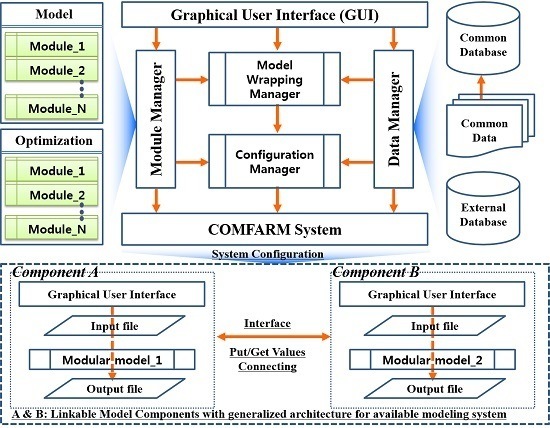Development of a Component-Based Modeling Framework for Agricultural Water-Resource Management
Abstract
:1. Introduction
2. Development of COMFARM
2.1. Basic Concept
2.2. Framework Architecture
3. Agricultural-Water Modeling System
3.1. Basic Element Modules
3.2. Modules for Hydrological Analysis
3.2.1. Rainfall-Runoff Simulation Model (TANK Model)
3.2.2. Reservoir Water Balance
3.2.3. Water Balance in Paddy Fields
3.2.4. Agricultural Water Supply
3.3. Case Study of COMFARM Application
3.3.1. Case-Study Basins and Database
3.3.2. Design of the Modeling System
3.3.3. Building the Modeling System for the Case Study
3.3.4. Performance Evaluation of the Modeling System
4. Discussion
4.1. Comparison with Previous Object Based Modeling Frameworks
4.2. Future Module Additions for Agricultural Watershed Modeling
Acknowledgments
Author Contributions
Conflicts of Interest
References
- UN Water. Coping with Water Scarcity—Challenge of the Twenty-First Century; FAO: Rome, Italy, 2007. [Google Scholar]
- Molden, D. Water for Food, Water for Life—A Comprehensive Assessment of Water Management in Agriculture; Springer: London, UK, 2007. [Google Scholar]
- Droogers, P.; Bastiaanssen, W.G.M.; Beyazgül, M.; Kayam, Y.; Kite, G.W.; Murray-Rust, H. Distributed agro-hydrological modeling of an irrigation system in western Turkey. Agric. Water Manag. 2000, 43, 183–202. [Google Scholar] [CrossRef]
- Beven, K.; Freer, J. A dynamic topmodel. Hydol. Process. 2001, 15, 1993–2011. [Google Scholar] [CrossRef]
- Douglas-Mankin, K.R.; Srinivasan, R.; Arnold, J.G. Soil and Water Assessment Tool (SWAT) model: Current developments and applications. Trans. ASABE 2010, 53, 1423–1431. [Google Scholar] [CrossRef]
- Her, Y.; Heatwole, C. Two-dimensional continuous simulation of spatiotemporally varied hydrological processes using the time-area method. Hydol. Process. 2016, 30, 751–770. [Google Scholar] [CrossRef]
- Rumbaugh, J.; Blaha, M.; Premerlani, W.; Eddy, F.; Lorensen, W. Object-Oriented Modeling and Design; Prentice-Hall: Upper Saddle River, NJ, USA, 1991. [Google Scholar]
- Argent, R.M.; Voinov, A.; Maxwell, T.; Cuddy, S.M.; Rahman, J.M.; Seaton, S.; Vertessy, R.A.; Braddock, R.D. Comparing modelling frameworks—A workshop approach. Environ. Model. Softw. 2006, 21, 895–910. [Google Scholar] [CrossRef]
- Clements, P.C. From subroutines to subsystems: Component-based software development. Am. Program. 1995, 8, 1–8. [Google Scholar]
- Zeigler, B.P. Object-Oriented Simulation with Hierarchical Modular Models; Academic Press: San Diego, CA, USA, 1990. [Google Scholar]
- Maxwell, T. A parsi-model approach to modular simulation. Environ. Model. Softw. 1999, 14, 511–517. [Google Scholar] [CrossRef]
- Muhanna, W.A. SYMMS: A model management system that supports model reuse, sharing, and integration. Eur. J. Oper. Res. 1994, 72, 214–243. [Google Scholar] [CrossRef]
- Guariso, G.; Hitz, M.; Werthner, H. An integrated simulation and optimization modelling environment for decision support. Decis. Support Syst. 1996, 16, 103–117. [Google Scholar] [CrossRef]
- Bennett, D. A framework for the integration of geographical information systems and modelbase management. Int. J. Geogr. Inf. Sci. 1997, 11, 337–357. [Google Scholar] [CrossRef]
- Reed, M.; Cuddy, S.M.; Rizzoli, A.E. A framework for modelling multiple resource management issues—An open modelling approach. Environ. Model. Softw. 1999, 14, 503–509. [Google Scholar] [CrossRef]
- HarmonIT. State of the Art Review: Work Package 1—IT Frameworks (HarmonIT); HR Wallingford Report SR 598; HR Wallingford Ltd.: Wallingford, UK, 2002. [Google Scholar]
- Argent, R.M. An overview of model integration for environmental applications—Components, frameworks and semantics. Environ. Model. Softw. 2004, 19, 219–234. [Google Scholar] [CrossRef]
- Allan, B.A.; Armstrong, R.; Bertrand, F.; Chiu, K.; Dahlgren, T.L.; Damevski, K.; Elwasif, K.D.; Epperly, T.G.W.; Govindaraju, M.; Katz, D.S.; et al. A component architecture for high-performance scientific computing. Int. J. High Perform. Comput. 2006, 20, 163–202. [Google Scholar] [CrossRef]
- Castronova, A.M.; Goodall, J.L. A generic approach for developing process-level hydrologic modeling components. Environ. Model. Softw. 2010, 25, 819–825. [Google Scholar] [CrossRef]
- Leavesley, G.H.; Markstrom, S.L.; Brewer, M.S.; Viger, R.J. The modular modeling system (MMS)—The physical process modeling component of a database-centered decision support system for water and power management. Water Air Soil Pollut. 1996, 90, 303–311. [Google Scholar] [CrossRef]
- Sydelko, P.J.; Majerus, K.A.; Dolph, J.E.; Taxon, T.N. A dynamic object-oriented architecture approach to ecosystem modeling and simulation. In Proceedings of the American Society of Photogrammetry and Remote Sensing Annual Conference, Portland, OR, USA, 17–21 May 1999.
- Rizzoli, A.E.; Davis, J.R.; Abel, D.J. Model and data integration and re-use in environmental decision support systems. Decis. Support Syst. 1998, 24, 127–144. [Google Scholar] [CrossRef]
- Costanza, R.; Voinov, A. Spatially Explicit Landscape Simulation Modeling; Springer: New York, NY, USA, 2003. [Google Scholar]
- Rahman, J.M.; Seaton, S.P.; Perraud, J.-M.; Hotham, H.; Verrelli, D.I.; Coleman, J.R. It’s TIME for a new environmental modelling framework. In Proceedings of the MODSIM 2003 International Congress on Modelling and Simulation, Townsville, Australia, 14–17 July 2003.
- Whelan, G.; Castleton, K.J.; Buck, J.W.; Hoopes, B.L.; Pelton, M.A.; Strenge, D.L.; Gelston, G.M.; Kickert, R.N. Concepts of a Framework for Risk Analysis in Multimedia Environmental Systems; Pacific Northwest National Laboratory: Richland, WA, USA, 1997. [Google Scholar]
- David, O.; Markstrom, S.L.; Rojas, K.W.; Ahuja, L.R.; Schneider, I.W. The object modeling system. In Agricultural System Models in Field Research and Technology Transfer; Ahuja, L.R., Ma, L., Howell, T.A., Eds.; CRC Press: Boca Raton, FL, USA, 2002; pp. 317–331. [Google Scholar]
- Gijsbers, P.J.A.; Moore, R.V.; Tindall, C.I. HarmonIT: Towards OMI, an Open Modelling Interface and Environment to harmonise European developments in water related simulation software. In Hydroinformatics 2002; Cluckie, I.D., Han, D., Davis, J.P., Heslop, S., Eds.; IWA Publishing: London, UK, 2002; Volume 2, pp. 1268–1275. [Google Scholar]
- Paik, K.; Kim, J.H.; Kim, H.S.; Lee, D.R. A conceptual rainfall-runoff model considering seasonal variation. Hydrol. Process. 2005, 19, 3837–3850. [Google Scholar] [CrossRef]
- Jang, T.; Kim, H.; Kim, S.; Seong, C.; Park, S. Assessing irrigation water capacity of land use change in a data-scarce watershed of Korea. J. Irrig. Drain. Eng. 2011, 138, 445–454. [Google Scholar] [CrossRef]
- Fumikazu, N.; Toshisuke, M.; Yoshio, H.; Hiroshi, T.; Kimihito, N. Evaluation of water resources by snow storage using water balance and tank model method in the Tedori River basin of Japan. Paddy Water Environ. 2013, 11, 113–121. [Google Scholar] [CrossRef]
- Hong, N.; Hama, T.; Suenaga, Y.; Aqili, S.W.; Huang, X.; Wei, Q.; Kawagoshi, Y. Application of a modified conceptual rainfall–runoff model to simulation of groundwater level in an undefined watershed. Sci. Total Environ. 2016, 541, 383–390. [Google Scholar] [CrossRef] [PubMed]
- Song, J.H.; Kang, M.S.; Song, I.; Jun, S.M. Water balance in irrigation reservoirs considering flood control and irrigation efficiency variation. J. Irrig. Drain Eng. 2016, 142, 04016003. [Google Scholar] [CrossRef]
- Li, X.; Guo, S.; Liu, P.; Chen, G. Dynamic control of flood limited water level for reservoir operation by considering inflow uncertainty. J. Hydrol. 2010, 391, 124–132. [Google Scholar] [CrossRef]
- Wu, Y.P.; Chen, J. An operation-based scheme for a multiyear and multipurpose reservoir to enhance macroscale hydrologic models. J. Hydrometeorol. 2012, 13, 270–283. [Google Scholar] [CrossRef]
- Kang, M.S.; Park, S.W.; Lee, J.J.; Yoo, K.H. Applying SWAT for TMDL programs to a small watershed containing rice paddy fields. Agric. Water Manag. 2006, 79, 72–92. [Google Scholar] [CrossRef]
- Kang, M.S. Development of Total Maximum Daily Loads Simulation System Using Artificial Neural Networks for Satellite Data Analysis and Nonpoint Source Pollution Models. Ph.D. Thesis, Seoul National University, Seoul, Korea, 2002. [Google Scholar]
- Kang, M.S.; Park, S.W. Development and application of total maximum daily loads simulation system using nonpoint source pollution model. J. Korea Water Resour. Assoc. 2003, 36, 117–128. [Google Scholar] [CrossRef]
- Monteith, J.L.; Szeicz, G.; Waggoner, P.E. The measurement and control of stomatal resistance in the field. J. Appl. Ecol. 1965, 2, 345–355. [Google Scholar] [CrossRef]
- Allen, R.G.; Jensen, M.E.; Wright, J.L.; Burman, R.D. Operational estimates of reference evapotranspiration. Agron. J. 1989, 81, 650–662. [Google Scholar] [CrossRef]
- Georgiou, P.E.; Papamichail, D.M. Optimization model of an irrigation reservoir for water allocation and crop planning under various weather conditions. Irrig. Sci. 2008, 26, 487–504. [Google Scholar] [CrossRef]
- Doorenbos, J.; Pruitt, W.O. FAO Irrigation and Drainage Paper No. 24: Crop Water Requirements; Food and Agriculture Organization of the United Nation: Rome, Italy, 1977. [Google Scholar]
- Wu, Y.; Chen, J. Estimating irrigation water demand using an improved method and optimizing reservoir operation for water supply and hydropower generation: A case study of the Xinfengjiang reservoir in southern China. Agric. Water Manag. 2013, 116, 110–121. [Google Scholar] [CrossRef]
- Chung, H.W.; Kim, S.J.; Kim, J.S.; Noh, J.K.; Park, K.U.; Son, J.K.; Yoon, K.S.; Lee, K.H.; Lee, N.H.; Chung, S.O.; et al. Irrigation and Drainage Engineering; Dongmyeong Publisher: Seoul, Korea, 2006. [Google Scholar]
- Willmott, C.J. On the validation of models. Phys. Georg. 1981, 2, 184–194. [Google Scholar]
- Moriasi, D.N.; Arnold, J.G.; Van Liew, M.W.; Bingner, R.L.; Harmel, R.D.; Veith, T.L. Model evaluation guidelines for systematic quantification of accuracy in watershed simulations. Trans. ASABE 2007, 50, 885–900. [Google Scholar] [CrossRef]
- Rahman, J.M.; Cuddy, S.M.; Watwon, F.G.R. Tarsier and ICMS: Two approaches to framework development. Math. Comput. Simul. 2004, 64, 339–350. [Google Scholar] [CrossRef]
- David, O.; Ascough, J.C., II; Lloyd, W.; Green, T.R.; Rojas, K.W.; Leavesley, G.H.; Ahuja, L.R. A software engineering perspective on environmental modeling framework design: The objective Modeling System. Environ. Model. Softw. 2012, 39, 201–213. [Google Scholar] [CrossRef]
- Rahman, J.M.; Seaton, S.P.; Cuddy, S.M. Making frameworks more useable: Using model introspection and metadata to develop model processing tools. Environ. Model. Softw. 2004, 19, 275–284. [Google Scholar] [CrossRef]
- Jeon, J.H.; Yoon, C.G.; Jung, K.W.; Jang, J.H. HSPF-Paddy simulation of water inflow and quality for the Saemangeum watershed in Korea. Water Sci. Technol. 2007, 56, 123–130. [Google Scholar] [CrossRef] [PubMed]
- Kim, S.M.; Im, S.J.; Park, S.W.; Lee, J.J.; Benham, B.L.; Jang, T.I. Assessment of wastewater reuse effects on nutrient loads from paddy field using field-scale water quality model. Environ. Model. Assess. 2008, 13, 305–313. [Google Scholar] [CrossRef]
- Sugawara, M. On the analysis of runoff structure about several Japanese rivers. Jpn. J. Geophys. 1961, 2, 1–76. [Google Scholar]
- Ahmad, S.W. Tank model application for runoff and infiltration analysis on sub-watersheds in Lalindu, Southeast Sulawesi province. Civ. Environ. Res. 2016, 8, 88–97. [Google Scholar]
- Heryansyah, A.; Goto, A.; Yanuar, M.J.P. Runoff modeling as a basis of a water quality hydrological model for Cidanau watershed, Banten Province, Indonesia. In Proceeding of the 3rd Seminar: Toward Harmonization between Developments and Environmental Conservation in Biological Production, Serang, Indonesia, 4–6 December 2003.
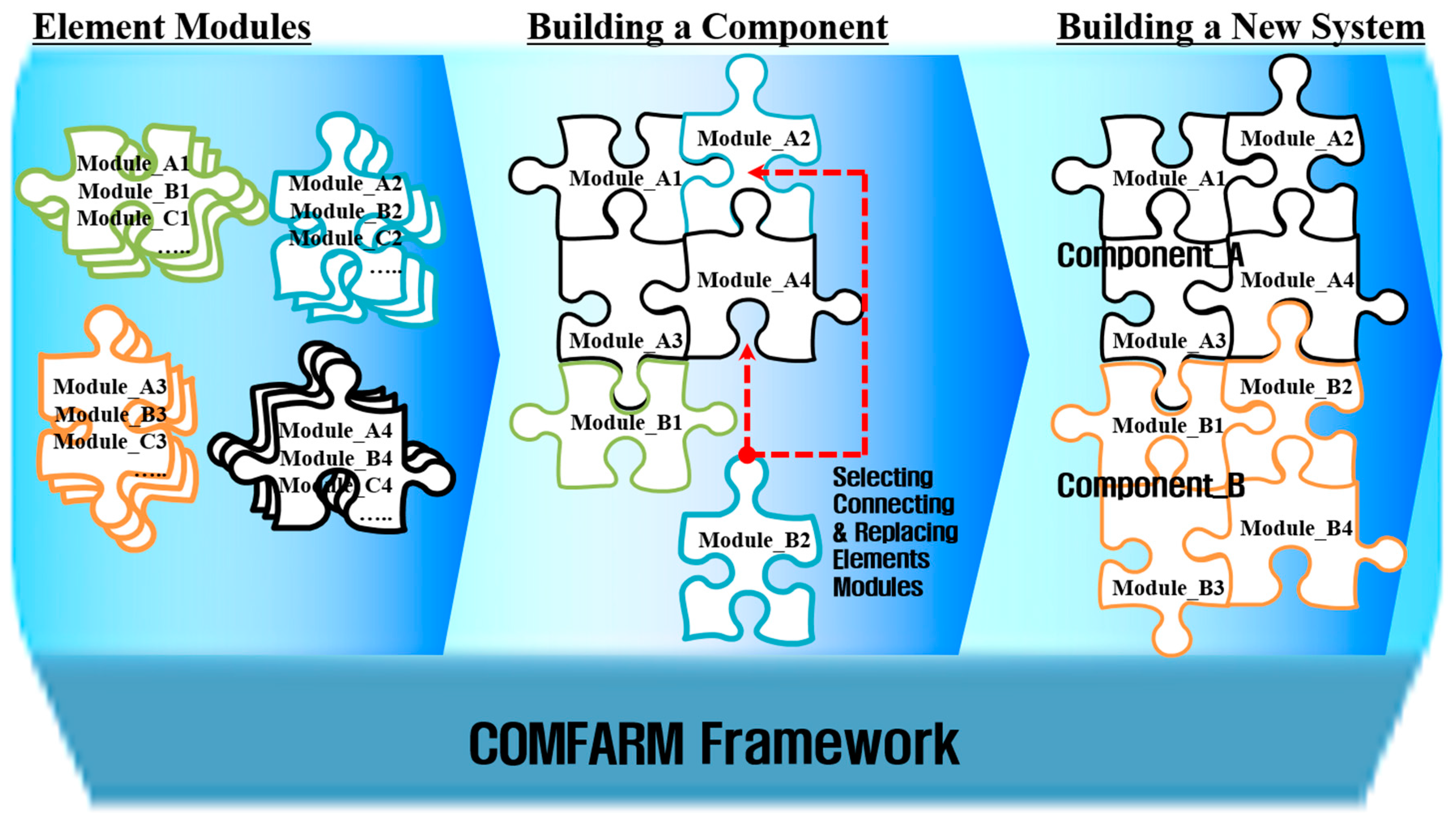
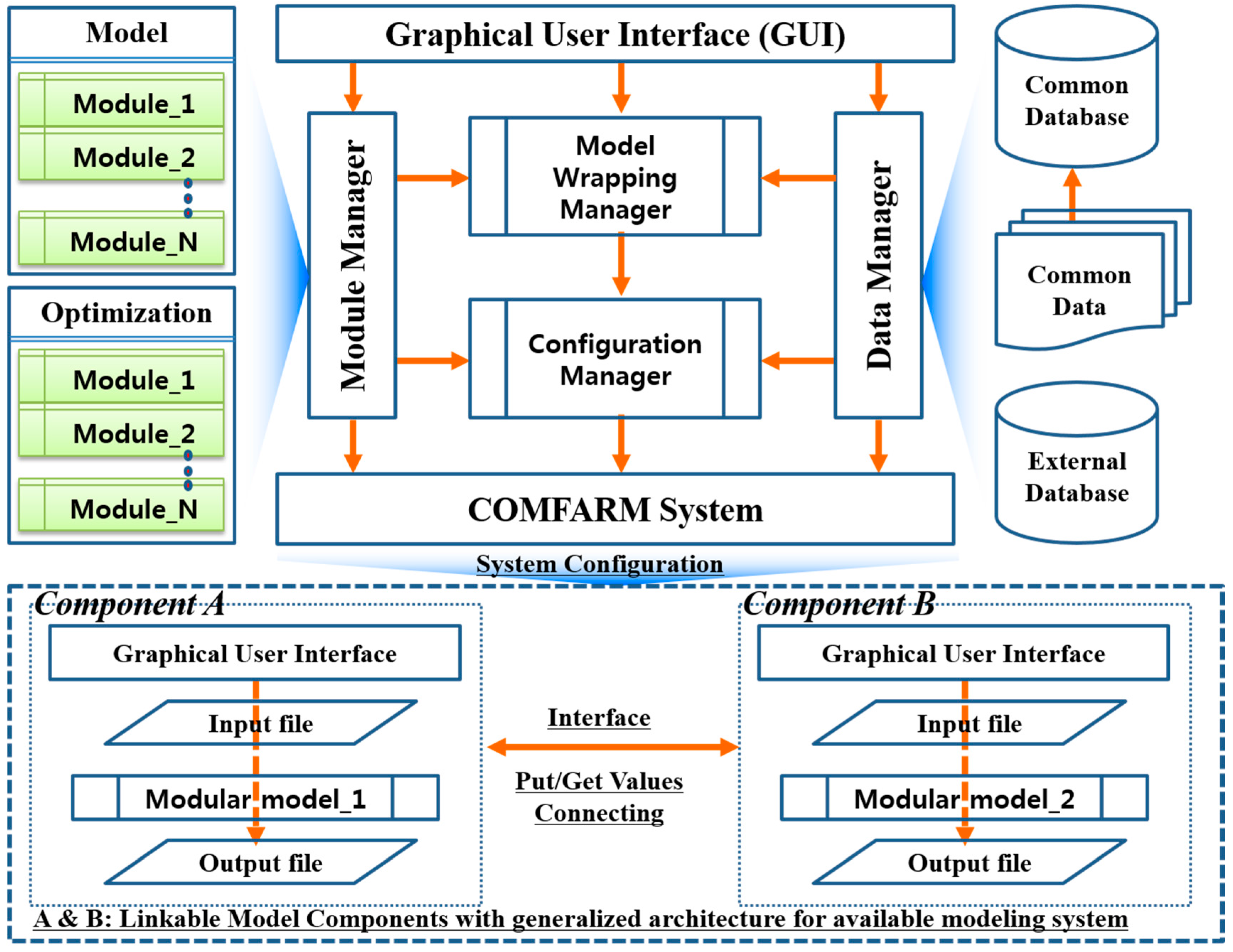
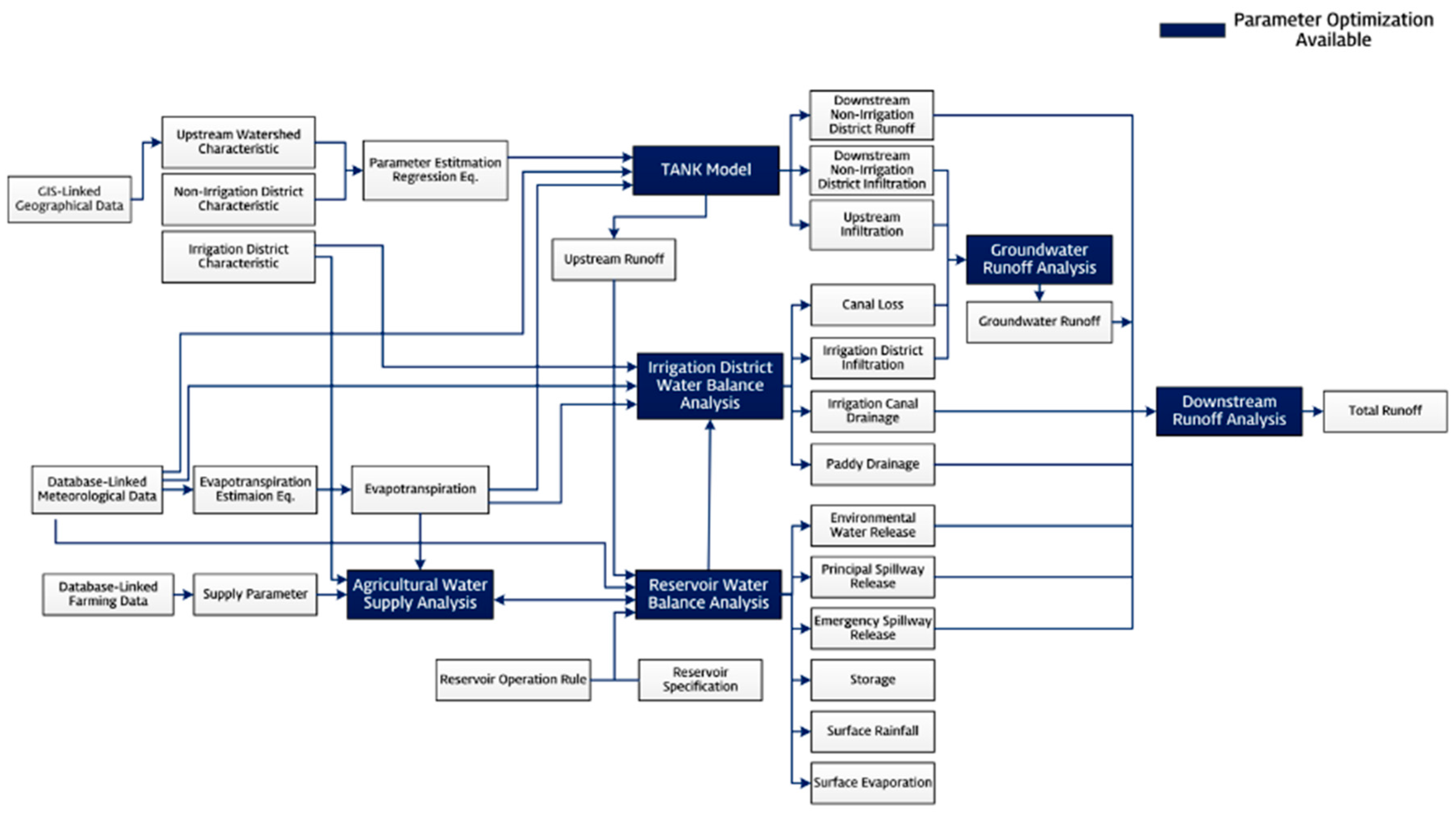
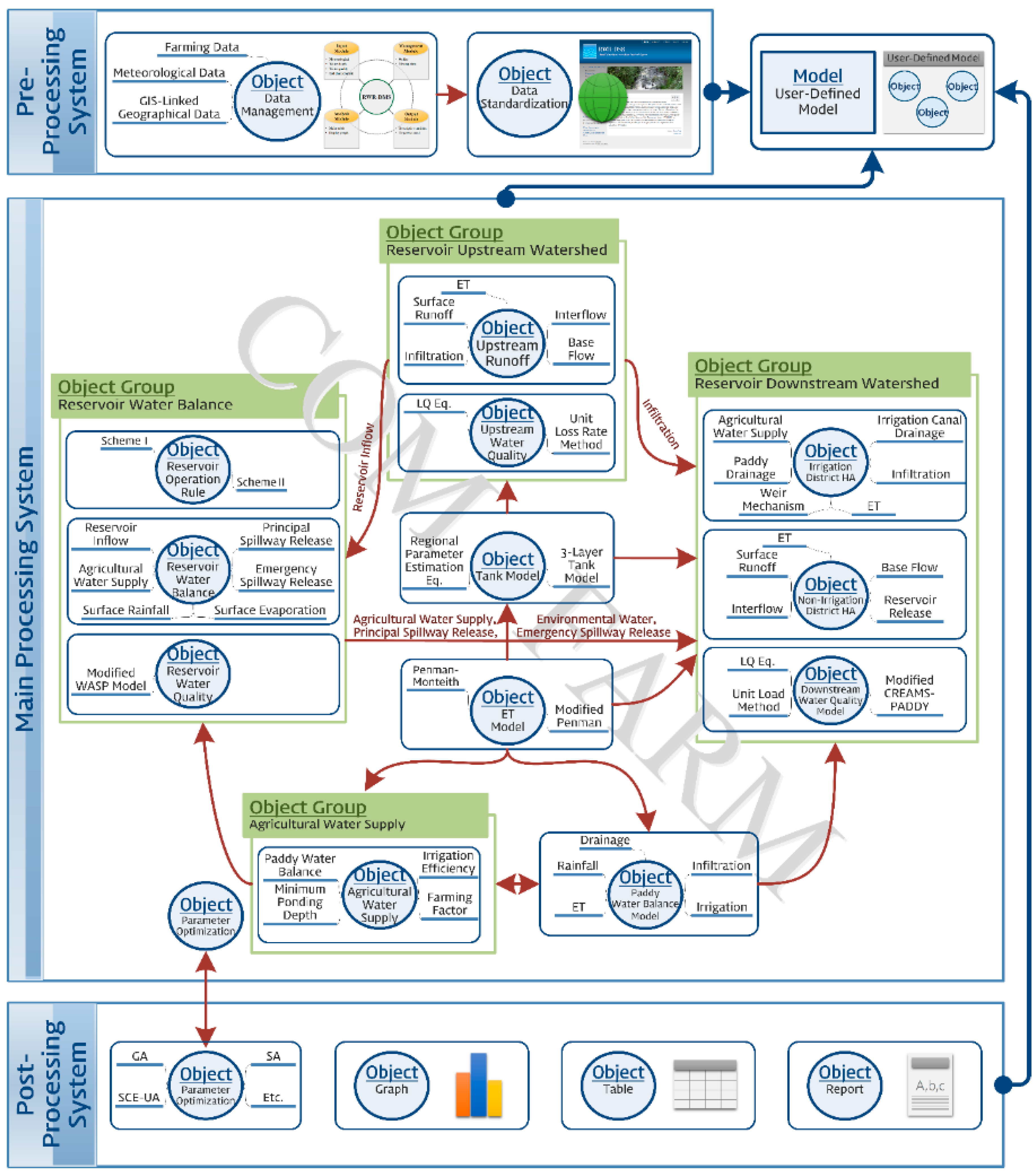
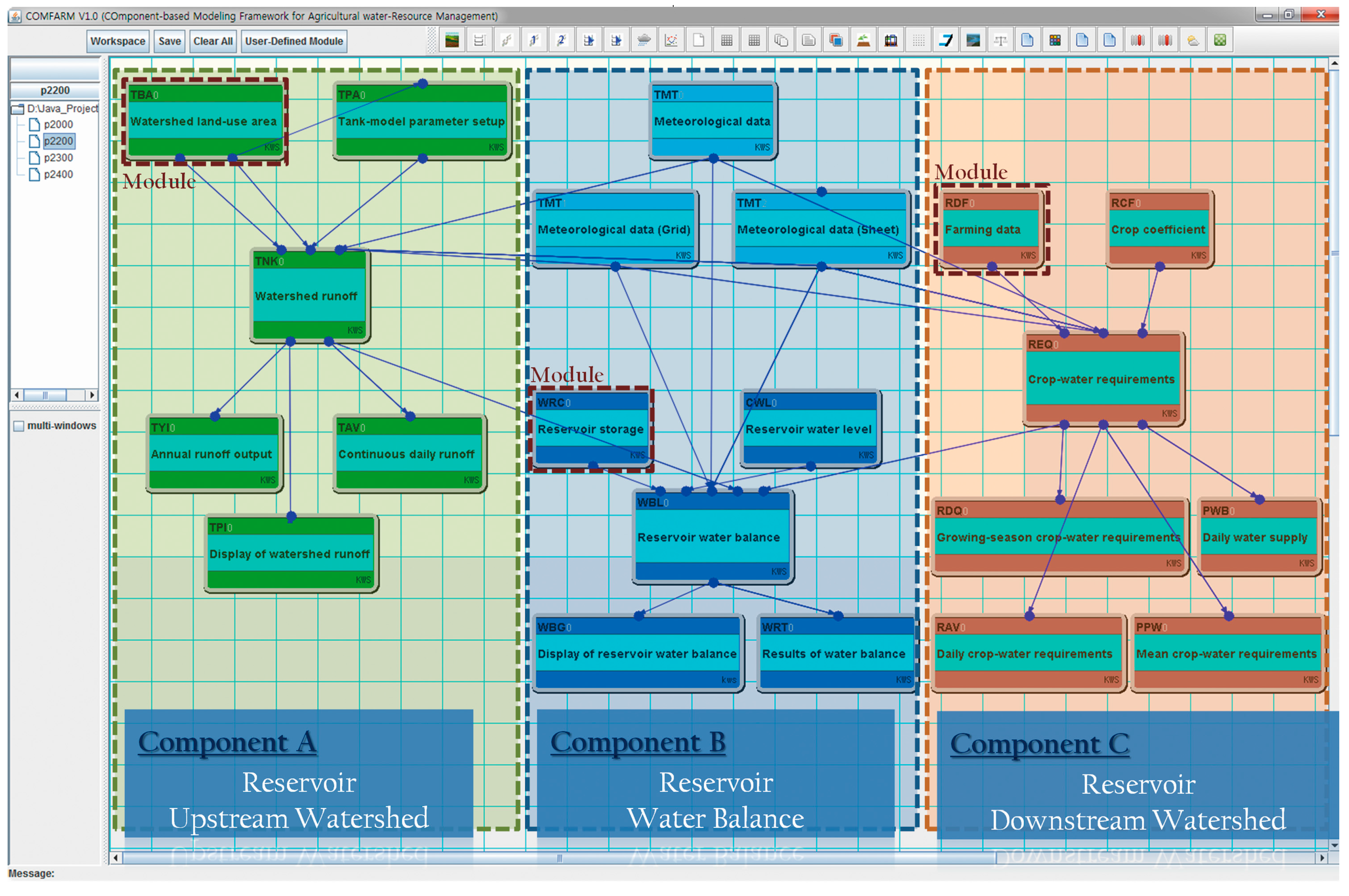

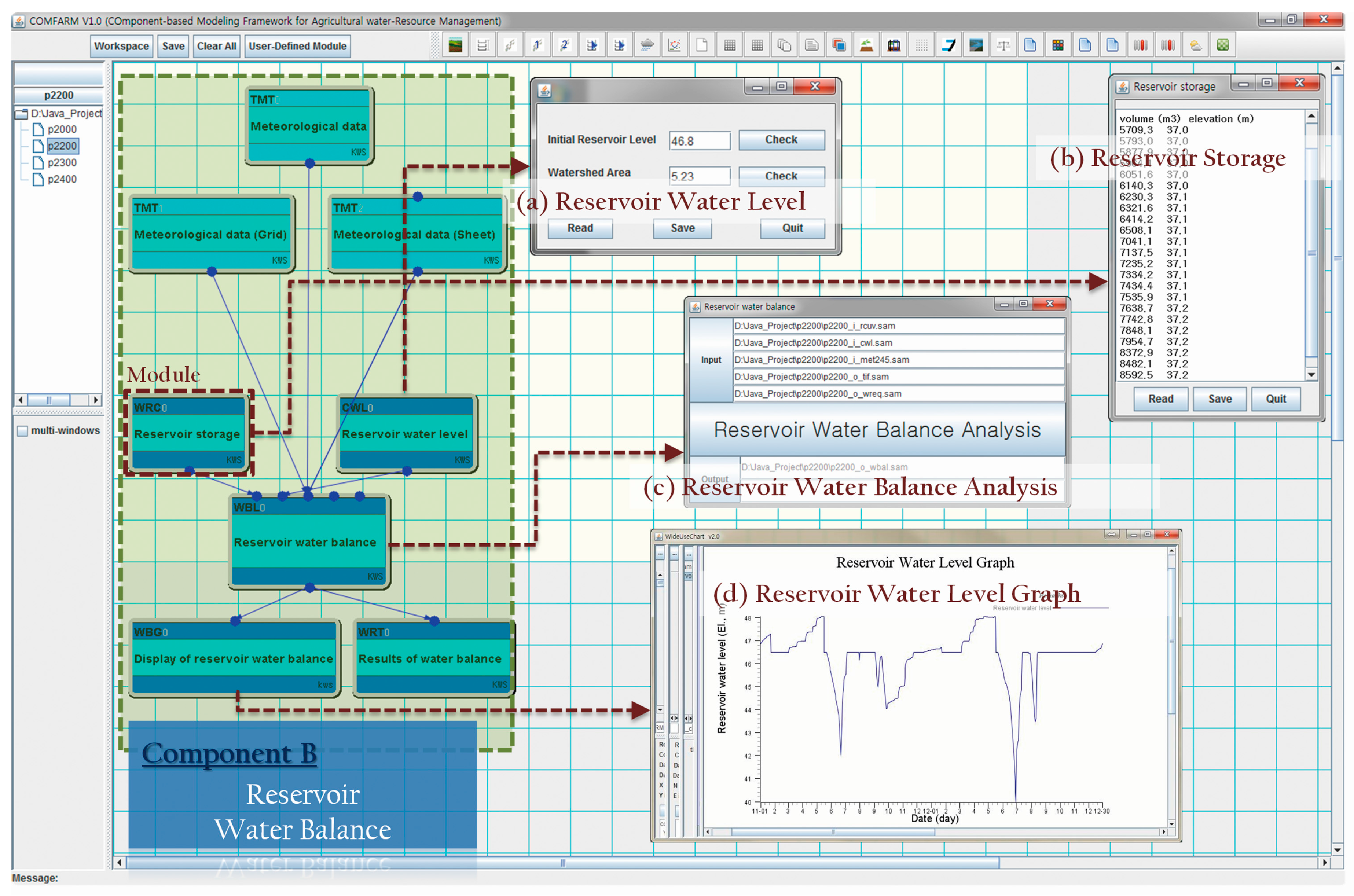
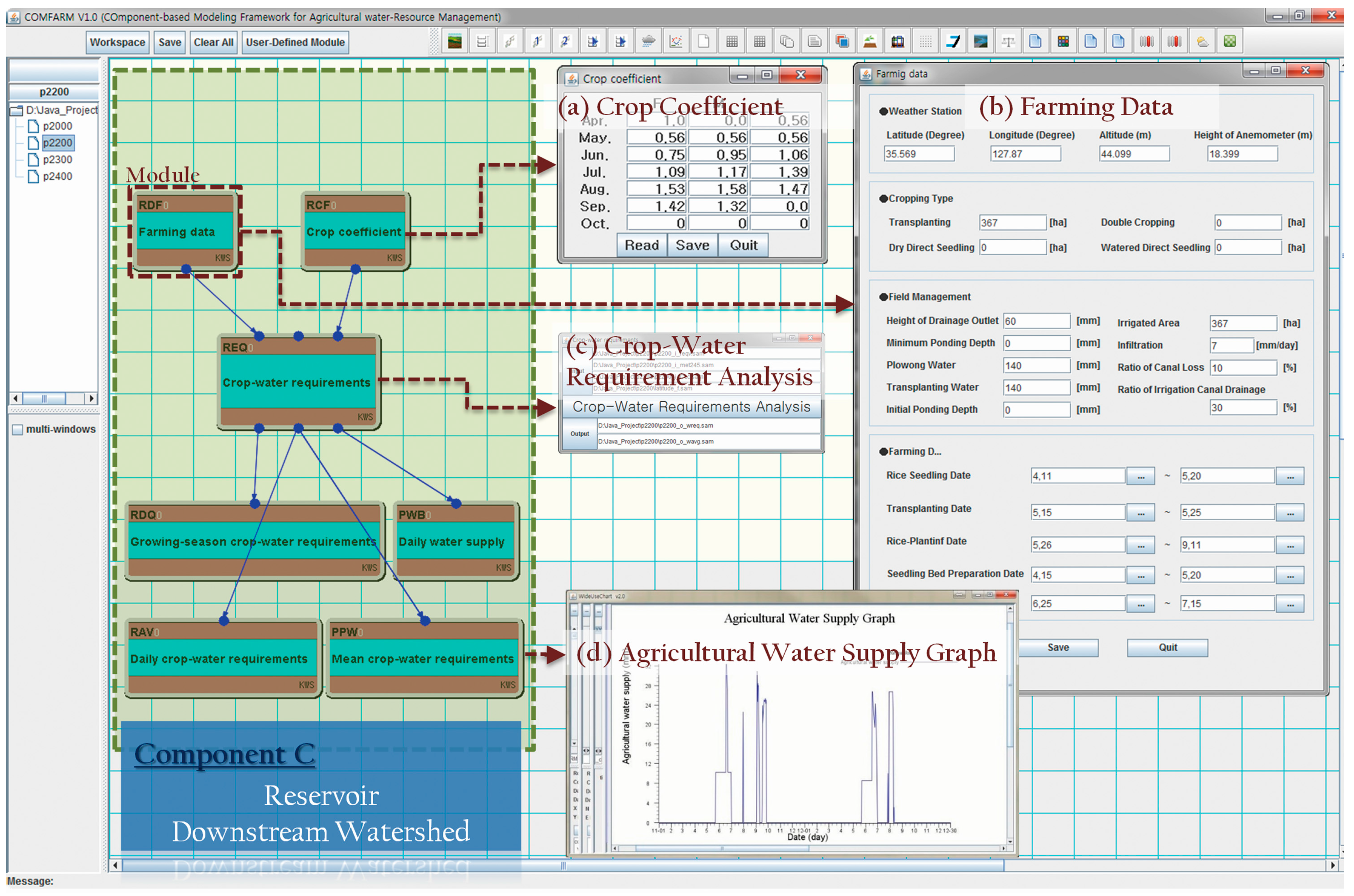
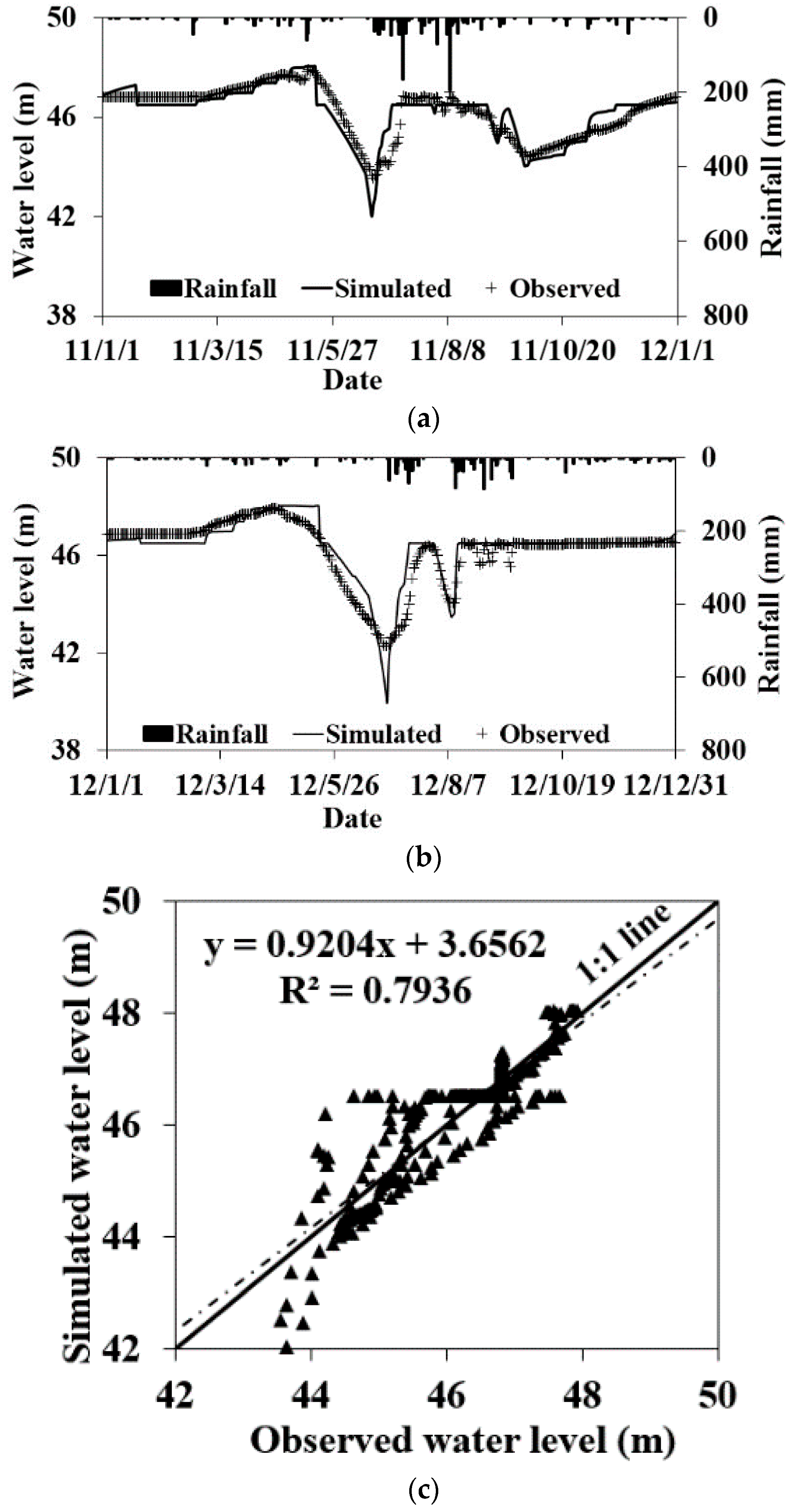
| Components | Module Name | Detailed Function Description |
|---|---|---|
| Reservoir’s upstream watershed runoff | Watershed land-use area | Input of the ratios of upland, paddy, and forest for an entire watershed area |
| TANK-model parameter setup | Determination of TANK-model parameters from the land-use ratios, including upland, paddy, and forest | |
| Meteorological data | Input of meteorological data, including rainfall, evaporation, temperature, relative humidity, solar radiation, and wind speed | |
| Meteorological data (Grid) | Input of grid-based meteorological data for the rainfall, evaporation, temperature, relative humidity, solar radiation, and wind speed | |
| Meteorological data (Spreadsheet) | Input of spreadsheet meteorological data for the rainfall, evaporation, temperature, relative humidity, solar radiation, and wind speed | |
| Watershed runoff | Simulation of the watershed runoff into a reservoir using the TANK model | |
| Annual runoff output | Daily runoff simulation with the TANK model on a yearly basis | |
| Continuous daily runoff | Continuous daily-runoff simulation with the TANK model for studying entire periods | |
| Display of watershed runoff | Graphical representation of the watershed runoff | |
| Reservoir water balance | Reservoir water balance | Reservoir balance between water inflow (watershed runoff and precipitation) and outflow (evaporation, irrigation, and discharge) |
| Reservoir storage | Reservoir storage estimation using water level and reservoir-storage volume relation | |
| Reservoir water level | Current setting for the reservoir water level | |
| Display of reservoir water balance | Graphical print of the reservoir water balance | |
| Results of water balance | Tabulated print of the reservoir water balance | |
| Agricultural water supply | Farming Data | Input of farming data including cropping types, height of drainage outlet, minimum ponding depth, infiltration, irrigated area, irrigation efficiency, and farming date |
| Crop-water requirements | Estimation of the crop-water requirements using an evapotranspiration equation | |
| Crop coefficient | Input of a crop coefficient for the evapotranspiration estimation | |
| Daily crop-water requirements | Daily crop-water requirements calculated from an evapotranspiration equation | |
| Growing-season crop-water requirements | Growing-season crop-water requirements calculated from an evapotranspiration equation | |
| Mean crop-water requirements | Graphical representation of the mean crop-water supply determined from the estimated evapotranspiration | |
| Daily water supply | Graphical representation of the daily water supply for crops based on the evapotranspiration estimation | |
| Downstream reservoir | Irrigation district analysis | Hydrological analysis of the reservoir’s irrigation districts |
| Non-irrigation district analysis | Hydrological analysis of the reservoir’s non-irrigation districts | |
| Downstream water quality | Water-quality simulation for the reservoir-irrigated paddy fields |
| Upstream Watershed of the Reservoir | Reservoir | Irrigation District | ||||||
|---|---|---|---|---|---|---|---|---|
| Area (km2) | Paddy (%) | Upland (%) | Forest (%) | Total Storage (104 m3) | Normal Pool Level (m) | Flood-Limited Level (m) | Dead Level (m) | Area (km2) |
| 5.23 | 14.0 | 8.8 | 54.4 | 85.4 | 48.0 | 46.5 | 37.0 | 2.22 |
© 2016 by the authors; licensee MDPI, Basel, Switzerland. This article is an open access article distributed under the terms and conditions of the Creative Commons Attribution (CC-BY) license (http://creativecommons.org/licenses/by/4.0/).
Share and Cite
Kang, M.-S.; Srivastava, P.; Song, J.-H.; Park, J.; Her, Y.; Kim, S.M.; Song, I. Development of a Component-Based Modeling Framework for Agricultural Water-Resource Management. Water 2016, 8, 351. https://doi.org/10.3390/w8080351
Kang M-S, Srivastava P, Song J-H, Park J, Her Y, Kim SM, Song I. Development of a Component-Based Modeling Framework for Agricultural Water-Resource Management. Water. 2016; 8(8):351. https://doi.org/10.3390/w8080351
Chicago/Turabian StyleKang, Moon-Seong, Puneet Srivastava, Jung-Hun Song, Jihoon Park, Younggu Her, Sang Min Kim, and Inhong Song. 2016. "Development of a Component-Based Modeling Framework for Agricultural Water-Resource Management" Water 8, no. 8: 351. https://doi.org/10.3390/w8080351
APA StyleKang, M.-S., Srivastava, P., Song, J.-H., Park, J., Her, Y., Kim, S. M., & Song, I. (2016). Development of a Component-Based Modeling Framework for Agricultural Water-Resource Management. Water, 8(8), 351. https://doi.org/10.3390/w8080351






